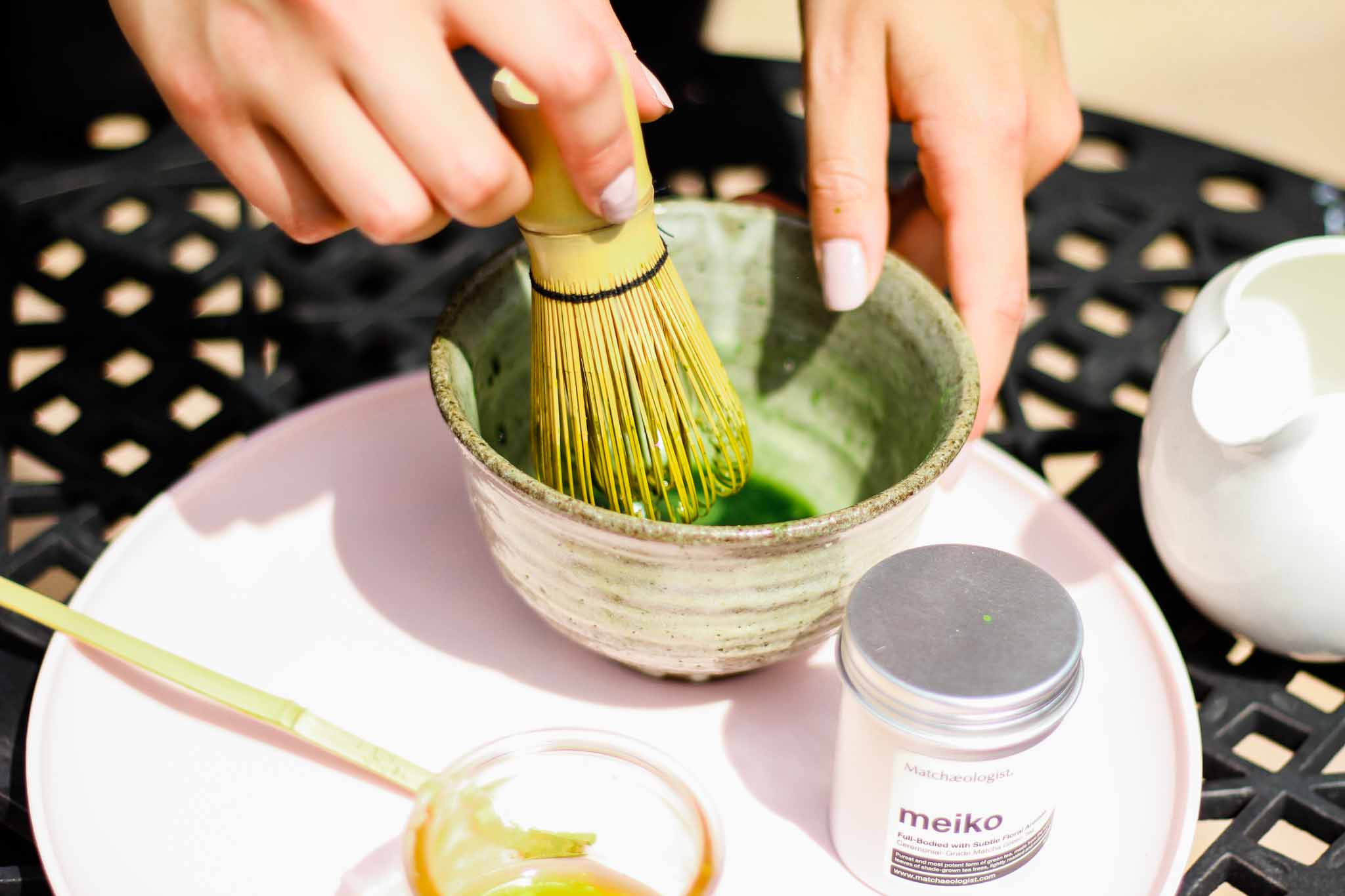Words and Photos by Kelly Franson
Let’s make a toast – cheers to purposeful sipping.

Matcha is beloved for its health benefits and brings the clarity and energy you need into your busy day. If you drink every sip of matcha with a purpose – whether that’s redeeming its sustained caffeine effects, appreciating its complex flavor profile, or acknowledging its historical significance – you can achieve some sense of mindfulness and “slowness” in your day!
THE HISTORY
Although matcha (抹茶, or “ground tea”) has become a cultural marker of Japan, its roots originate in China where Buddhist monks incorporated tea into their daily meditative rituals.
Lu Yu and the Birth of Tea Culture
During the Tang Dynasty (733 – 804 AD), Chinese scholar Lu Yu solidified the preparation and consumption of tea as a form of mindful art. Preceding time periods predominately drank tea for medicinal purposes in the form of “tea soup”. Lu Yu made his tea by boiling powdered tea in water and adding salt.
The Beginnings of Whipped Tea
The Song Dynasty in China (960 – 1279 AD) is credited for having popularized the preparation of whipped, powdered tea in tea whisking competitions. The standards for an ideal cup of tea shifted towards achieving a glossy, smooth, white froth.
Zen Buddhists and the Japanese Tea Ceremony
In the 12th century, Zen Buddhists studying in China brought green tea back to Japan because they found it helped them with meditation. Myoan Eisai, the founder of Zen Buddhism, was especially responsible for facilitating a widespread interest in matcha among the newly ascendant samurai class. It wasn’t until the 16th century that the elaborate Japanese tea ceremony where matcha plays an integral part was formalized by the Zen monk Sen no Rikyū.
What is Matcha?
There are a slew of misconceptions surrounding what matcha is and how it differs from other types of tea. To put it simply, matcha is a variety of green tea that is grinded into a fine powder and whisked with hot water to make a frothy cup of tea. Matcha begins as a camellia sinensis plant, much like other leaf teas. Three to four weeks prior to its harvest, the camellia sinensis plants are shaded to enable for greater chlorophyll development and flavor enhancement. This is also how leaves for sencha green tea are grown – the only difference is the post-harvest processing. Once the top two to three leaves are plucked from the tea plants in the Spring, the leaves enter the kill-green phase which applies heat through steam to immediately stop the oxidation process. Other types of leaf teas such as black tea are allowed to oxidize further and thus will turn a darker brown shade. For green tea sencha leaves that are to be turned into matcha, they are dried, deveined, and finely ground using a stonemill. At this point, the powder should be vibrant green and smooth enough to be whisked with water to drink. The idea of consuming the “whole tea leaf” versus drinking only water that has been brewed in tea leaves is what leads many to believe that matcha offers greater health benefits than regular dried green tea.
When it comes to sourcing quality matcha, there are a few pointers you can keep in mind. First, there are different quality grades of matcha. Ceremonial grade is the highest quality that uses the youngest, most tender leaves which results in a vibrant green hue and beautifully smooth froth perfect for drinking on its own as traditional tea. Premium grade, or what a lot of brands usually market as “cafe grade”, is of a slightly lower quality and is suitable for everyday occasions or in lattes. The lowest quality is culinary grade which has the dullest hue and will be too bitter to drink – it’s perfect for using in baked goods or smoothies.
In addition to distinguishing between different qualities of matcha, consumers can also try to learn more about the producer and where their matcha is grown. Much like how single-origin coffee or chocolate is celebrated for its purity and quality, single-origin matcha offers the same effect. The majority of matcha brands in the US carry blends of matcha which often means that they’re sourcing from a variety of large tea farms in Japan to compensate for lower qualities across the board. In these cases, it’s difficult to identify the specific farmers and their production methods. Another aspect to be wary of is the labeling of “USDA Organic” which many deep-pocketed US brands proudly tout. However, matcha products can receive the “USDA Organic” certification as long as they have some fraction of organic ingredients within the blend. On the other hand, JAS organic or the Japanese standard for organic certification requires all products to have 95% or more organic content, a much more rigorous standard than the USDA labeling.
Let’s make a cup of matcha!
My favorite way to prepare matcha is via the traditional “uscuha” or “thin tea” method which produces a beautiful light green froth. Here are the steps:


STEP ONE: Sifting
Using the chashaku (bamboo tea scoop), scoop 2g (2 scoops) of matcha into your tea sifter which should be placed on your chawan (tea bowl).
STEP TWO: Add water
Add 1/4 cup of hot water to the sifted powder (the water should be around 80 degrees celcius, 176 degrees F – not boiling!)
STEP THREE: Whisking
With an “M” shaped motion, use your chasen (bamboo whisk) to whisk the matcha back-and-forth quickly.
STEP FOUR: Enjoy!
When the froth looks smooth and glossy, you’re ready to sip and enjoy! Remember to rinse your whisk with hot water and wipe your bamboo scoop with a damp cloth.
If you’d like to support the Slow Food movement while learning more about fun ways to use matcha, check out Kelly’s virtual “Magic of Matcha” Airbnb experience in partnership with Slow Food International.
For more matcha inspiration, check out @matchaandmoi on Instagram!


